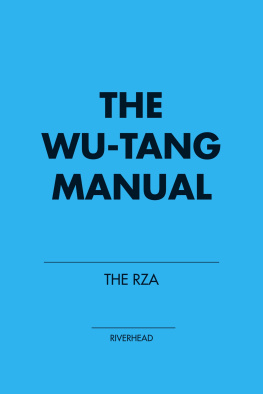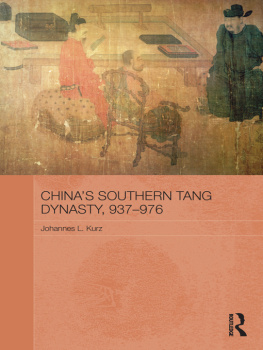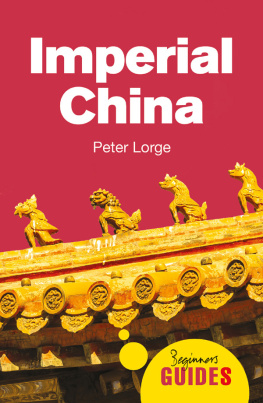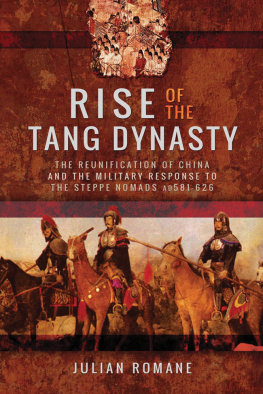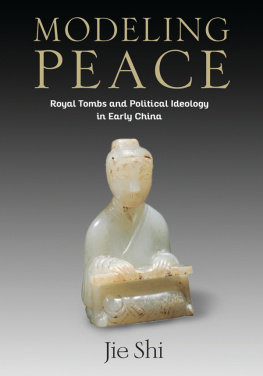
Imperial Tombs in Tang China, 618907
This important landmark book examines the religious, political, social and artistic significance of the imperial tombs of the Tang dynasty (AD 618907). It explores, in detail, the finest recently excavated Chinese tombs of the Tang period, focusing on the architectonic form of these mausolea and the content and aesthetics of their magnificent mural paintings.
In introducing a selection of imperial, aristocratic and official tombs, the book highlights the fascinating circumstances of burial. The author sets the tombs in the broader context of Chinese culture and discusses such issues as the Tang concept of the soul and the afterlife, the politics of mausoleum architecture, the official status of women and the implications for the living of the burial conditions of family members. This intellectually and visually stimulating book is the first up-to-date, accessible presentation of the Tang tombs.
Dr Tonia Eckfeld is Senior Fellow in Art History and Asian Studies at the University of Melbourne. She lectures internationally on the art and architectural history of China, India and Japan. She has conducted extensive research throughout Asia and has received numerous academic awards, including a research fellowship to Harvard.
RoutledgeCurzon Studies in the Early History of Asia
1 Imperial Tombs in Tang China, 618907
The politics of paradise
Tonia Eckfeld
Imperial Tombs in Tang China, 618907
The politics of paradise
Tonia Eckfeld
First published 2005
by RoutledgeCurzon
2 Park Square, Milton Park, Abingdon, Oxon OX14 4RN
Simultaneously published in the USA and Canada
by RoutledgeCurzon
270 Madison Ave, New York, NY 10016
This edition published in the Taylor & Francis e-Library, 2005.
To purchase your own copy of this or any of Taylor & Francis or Routledges collection of thousands of eBooks please go to www.eBookstore.tandf.co.uk.
RoutledgeCurzon is an imprint of the Taylor & Francis Group
2005 Tonia Eckfeld
All rights reserved.No part of this book may be reprinted or reproduced or utilized in any form or by any electronic, mechanical, or other means, now known or hereafter invented, including photocopying and recording, or in any information storage or retrieval system, without permission in writing from the publishers.
British Library Cataloguing in Publication Data
A catalogue record for this book is available from the British Library
Library of Congress Cataloging in Publication Data
Eckfeld, Tonia, 1957
Imperial tombs in Tang China, 618907 : the politics of paradise / Tonia Eckfeld
p. cm. (RoutledgeCurzon studies in the early history of Asia; 1)
Inculdes bibliographical references and index.
1. China Kings and rulers Tombs. 2. China History Tang dynasty, 618907. 3. Tombs China. I. Title. II. Series.
| DS719.E35 2004 |
| 951'.017dc22 | 2004004780 |
ISBN 0-203-01962-8 Master e-book ISBN
ISBN 041530220X (alk. paper)
To my parents
Contents
Illustrations
Colour plates (between pages 84 and 85)
1 Xingningling mausoleum
2 Shunling mausoleum
3 Pottery figurines of a military official and a civil official from Li Xians tomb
4 Painting of female attendants Yides tomb, rear chamber
5 The passage of Li Xians tomb
6 Painting of protection guards Li Xians tomb passage
7 Painting of triple gate towers Yides tomb passage
8 Painting of riderless horse, groom and attendants Li Shous tomb tunnel
9 Painting of Chinese officials and foreign emissaries Li Xians tomb tunnel
10 Painting of a hunting scene (detail) Li Xians tomb passage
11 Painting of a contemplative sage Wei Haos tomb, front chamber
12 Painting of landscape (detail) Jiemins tomb passage
13 Painting of female performers Li Xians tomb, front chamber
14 Painting of four female court attendants Princess Xinchengs tomb chamber
15 Painting of a woman with a red shawl Li Xians tomb, front corridor
16 Painting of Watching a bird while catching a cicada Li Xians tomb, front chamber
Figures
Tables
Chronology of Chinese periods
| c.1700 BC | 1050 BC | Shang dynasty |
| c.1050 | 221 | Zhou dynasty |
| c.1050 | 771 | Western Zhou |
| 770 | 221 | Eastern Zhou |
| 770 | 475 | Spring and Autumn period |
| 475 | 221 | Warring States period |
| 221 BC | 206 BC | Qin dynasty |
| 206 BC | AD 220 | Han dynasty |
| 206 BC | AD 9 | Western Han |
| AD 9 | AD 23 | Xin |
| 25 | 220 | Eastern Han |
| 220 | 280 | Three Kingdoms period |
| 220 | 280 | Wei |
| 221 | 263 | Shu-Han |
| 222 | 280 | Wu |
| 265 | 420 | Jin dynasty |
| 265 | 316 | Western Jin |
| 222 | 280 | Eastern Jin |
| 386 | 589 | Northern and Southern dynasties |
| 420 | 589 | Southern dynasties |
| 420 | 479 | Song |
| 479 | 502 | Qi |
| 502 | 557 | Liang |
| 557 | 589 | Chen |
| 386 | 581 | Northern dynasties |
| 386 | 534 | Northern Wei |
| 534 | 550 | Eastern Wei |
| 550 | 577 | Northern Qi |
| 535 | 557 | Western Wei |
| 557 | 581 | Northern Zhou |
| 581 | 618 | Sui dynasty |
| 618 | 907 | Tang dynasty |
| 907 | 960 | Five dynasties period |
| 907 | 1125 | Liao dynasty |
| 960 | 1279 | Song dynasty |
| 960 | 1127 | Northern Song |
| 1127 | 1279 | Southern Song |
| 1115 | 1234 | Jin dynasty |
| 1279 | 1368 | Yuan dynasty |
| 1368 | 1644 | Ming dynasty |
| 1644 | 1911 | Qing dynasty |
Acknowledgements
My chance discovery of a folio of photographs of tomb paintings in a little bookshop in Melbournes Chinatown in 1996 was a tiny event which led me on a greater journey of discovery, both intellectual and actual, to the tombs of Tang dynasty China, built more than a thousand years ago in the seventh to ninth centuries. The pictures of magnificent mural paintings belonging to the tomb of Crown Prince Li Xian (654684) raised more questions than they answered. Excavation of the tomb, and the few Chinese publications available which documented it, dated from the Cultural Revolution, and my immediate investigations uncovered little to satiate my curiosity about the character, history and purpose of the tomb and the fate of its occupant. What followed was a quest to unlock the mystery and meaning of that tomb. My preoccupation for the next three years took me across the world, and culminated in my doctoral thesis The Tomb of Li Xian: Posthumous Rehabilitation and Political Legitimacy. That analysis of the Tang dynastys use of imperial tomb location, architectonic form and mural decoration to affirm the posthumous status of the deceased and the political legitimacy of the emperor, was the first detailed and thorough study of a single Tang tomb.


